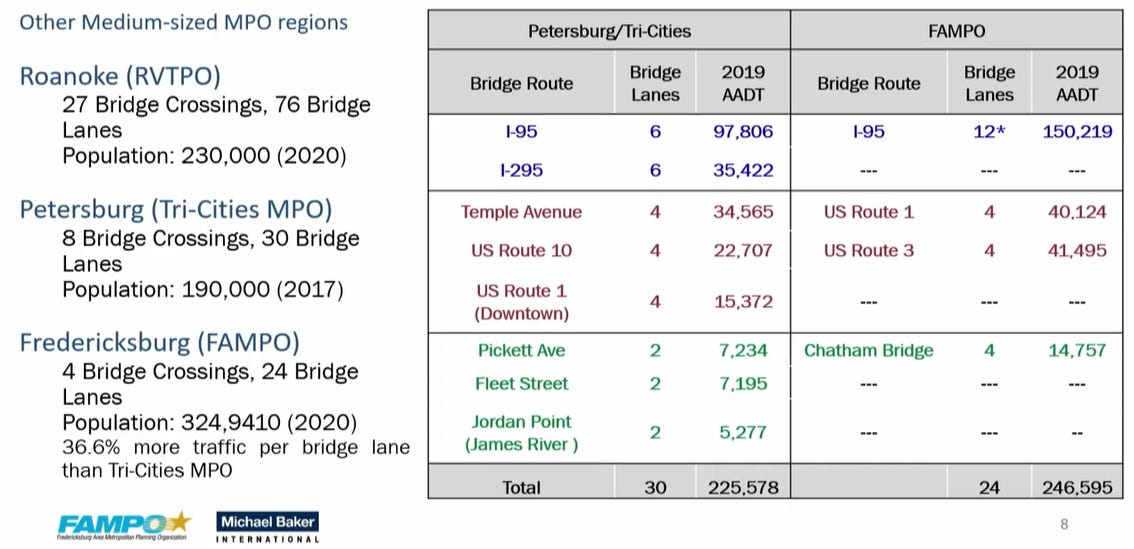A World of Change
The future of the Fredericksburg region is here now, if we are bold enough to take it.
By Martin Davis
EDITOR-IN-CHIEF
Email Name

The region is moving into summer, with children looking forward to vacations and pools and days away from school. By the time today’s youth become adults, however, the region they call home today will look remarkably different from what it does now.
The proof of this has been plan to see over the past two weeks, as significant debates and decisions about traffic, education, and housing have been in the headlines.
Traffic
Choosing the spot for the long-talked-about, yet-to-be-constructed river crossing got a boost this week when the Stafford County Board of Supervisors in a work session selected Option C as its preferred choice for where to build the bridge that may eventually cross the Rappahannock.
Even if Option C were approved today, however, we are a minimum of 10 years away from seeing the bridge become reality. But the reality is that the timeline for the decision to be made is now — more delays will have profound implications for the future. In 25 years, the region is facing the prospect of gridlock on I95; Rts. 1, 3, and 17; and Garrisonville Road if another crossing fails to materialize.
The seriousness of the situation was best characterized by Ian Ollis, the Fredericksburg Area Metropolitan Planning Organization director, who presented a slide comparing the number of river crossings in Virginia cities of similar size.
“The numbers are there for you,” Ollis said. “We have 36% more traffic per lane” than Roanoke or Petersburg.
“To provide additional north-south travel capacity west of I95 to support the establishment of an interconnected grid system,” he continued, is essential because “our grid system of roads has got some missing links.” And a grid, he continued, “is limited by rivers.”
For the Option C crossing to become a reality, the Stafford Board of Supervisors will need to formally approve it as a Board and then support it, along with either Fredericksburg or Spotsylvania, at the upcoming FAMPO policy meeting on June 16.
The river crossing alone won’t solve our problems, of course. Consider the congestion issues along I95.
The stretch of that interstate that runs from the Prince William-Stafford line through Caroline County has been plagued by ongoing total lane shutdowns in either the north or south direction over the past two years — 60 times in total.
This information was provided exclusively to the Advance in a piece by Hank Silverberg. And when these shutdowns happen, the snarls it creates move far beyond the interstate.
“Detours and traffic backups are more disruptive in this region,” Greenberg wrote, “because there is only one real alternative roadway—U.S. Route 1.”
Mike Corwin, V-DOT’s District Traffic Operations Engineer, told the Advance that there is no other road that can handle the full workload of I-95, but they do have control of traffic lights by computer which can be adjusted to move traffic more quickly along U.S. Route 1.
“That sounds really good,” he said, “unless you are sitting on a side street.” There, traffic further jams because GPS and other on-line traffic guides often offer alternative routes through communities, clogging local traffic.
The issues before us are obvious. We are running out of time to act.
Higher Education
Recent Trump Administration rulings regarding student visas have drawn national attention, and they may have an impact not only on incoming international students at the University of Mary Washington, but potentially have effects on Virginia’s overall economy.
There are some 90 international students currently at UMW. According to Amy Jessee, executive director of university communications for the university, the school is “not aware of any student visas being impacted at this time.” However, she did say that UMW’s “Center for International Education continues to work with students on their educational plans, including any further guidance for incoming students scheduling their appointments this summer.”
Across the state, the problem is more pronounced. Research I universities like the University of Virginia and Virginia Tech have significant international student populations. Typically, these students pay full freight to attend, meaning a significant loss of students could affect the universities’ bottom lines. And it could hurt the commonwealth’s overall economy, as well.
Virginia ranks No. 16 on the list of U.S. states in terms of the dollars international students contribute to the economy - $807.2 million. They also create 7,650 jobs.
The loss of international students and their income, however, aren’t the only challenges facing our universities. As challenging are escalating tuition rates and declining student populations.
The projected declining population of enrollees is partly due to demographics. However, it’s also true that what students are searching for in higher education is changing.
At the forefront of finding innovative ways to serve the next generation of students is Germanna Community College, whose president, Dr. Janet Gullickson, is retiring. Her list of accomplishments has been extraordinary, making Germanna an educational powerhouse that is the envy of Virginia.
As Germanna looks for its next leader, continuing the dynamic growth and innovation the school experienced under Gullickson’s tenure will be crucial.
And Virginia’s second-tier universities would do well to learn from its community college partners.
Housing
The shortage of affordable housing is not limited to our region alone. It is a national concern that will require both national- and state-level solutions.
Some early efforts at those state-level solutions met stern resistance at the Stafford County Board of Supervisors’ work session this past week.
One bill that passed was HB 2660, which “Shortens the timeframes for various local government approvals of subdivision plats and site plans.” The net effect of this bill would require locality staff to shrink the turn-around time for plan reviews by 25% to 35%, according the presentation delivered at the meeting.
The most stringent response to this bill was delivered by Supervisor Meg Bohmke, who called it “onerous.”
While the new law certainly puts pressure on localities to reduce the time it takes to get housing development underway, multiple reports make clear that changes in the way Virginia develops new housing have to change.
The 2024 JLARC study on affordable housing states unequivocally that “Virginia has a shortage of housing available for lower income households.” And that shortage is compounded by a severe shortage in rental properties, with there being a “shortage of at least 200,000 affordable rental units statewide,” most of which are in Northern and Central Virginia.
A more targeted study of the problem locally was performed by the Fredericksburg Assocation of Realtors this year. The Advance in summarizing the report noted that the area needs 2,400 additional housing units each year between now and 2050. And Chip Boyles, director of the George Washington Regional Commission, told the Advance that “the more immediate results have to come from the local governments.”
Jeh Hicks, president of the Fredericksburg Area Homebuilders Assocation, said the following of the Stafford Board of Supervisors’ reaction to the new legislation: “It was certainly disappointing to watch the Board’s response to legislation intended to increase efficiency and create accountability in the plan review process. This is a problem with jurisdictions across the commonwealth, as it tends to be an easy thing to de-prioritize. Staffing in planning departments is a particular problem in our area that can impact the efficiency of this process.”
We Know the Need, We Need the Will
The issues that residents and area professionals and legislators alike have seen coming for the better part of the past quarter century are now here. The debates of the past couple of weeks are part and parcel of what we can expect in the months ahead on traffic, education, and housing, among many other issues.
That debate is a healthy thing. At the end of it, however, the region must have not just actionable plans, but plans on the books to address the problems that are here.
The needs are well-known, well-studied, and many have viable solutions and workable models to act on.
Further, thanks to data centers, the additional revenue to address many of these issues is coming.
We just need to find the will.
We needn’t look far to find it. It’s in the eyes of children at play this summer. It’s their future we’re building for.
Support the Advance with an Annual Subscription or Make a One-time Donation
The Advance has developed a reputation for fearless journalism. Our team delivers well-researched local stories, detailed analysis of the events that are shaping our region, and a forum for robust, informed discussion about current issues.
We need your help to do this work, and there are two ways you can support this work.
Sign up for annual, renewable subscription.
Make a one-time donation of any amount.
Local Obituaries
To view local obituaries or to send a note to family and loved ones, please visit the link that follows.
This article is published under Creative Commons license CC BY-NC-ND. It can be distributed for noncommercial purposes and must include the following: “Published with permission by FXBG Advance.”














Excellent coverage, as usual. THANK YOU!
What is the best way for residents to help promote the long-overdue river crossing?